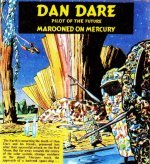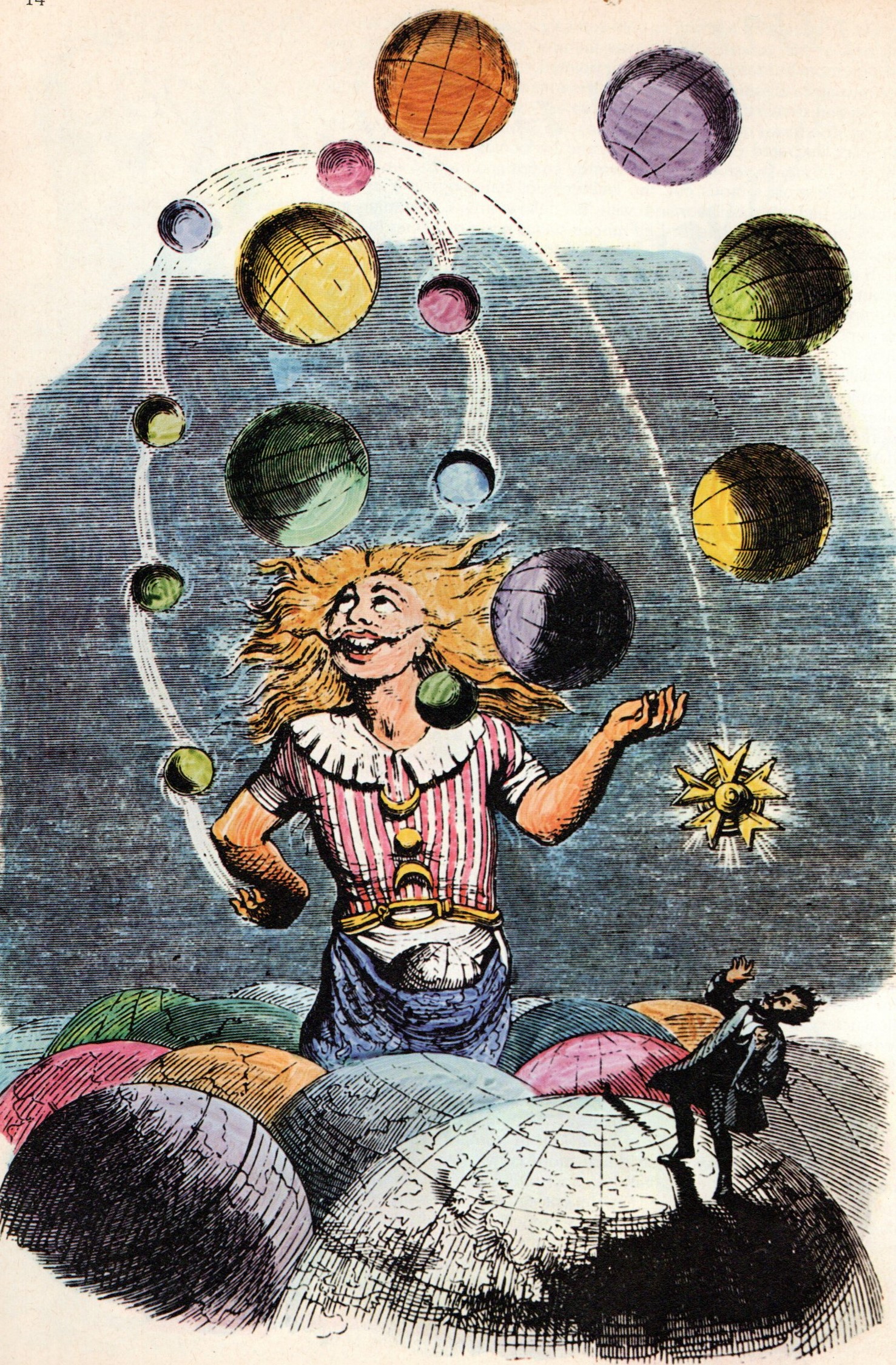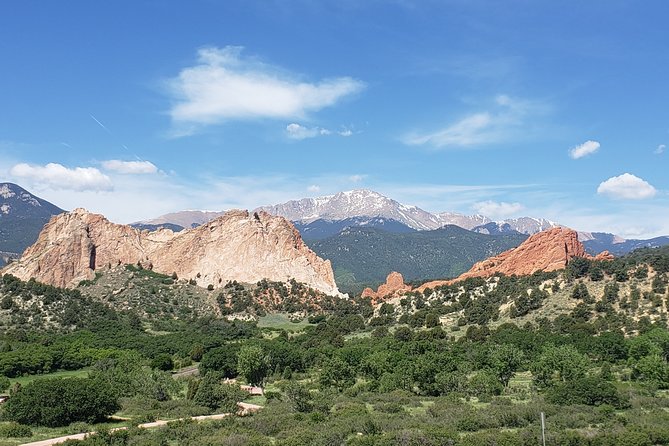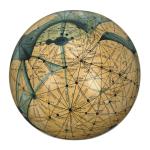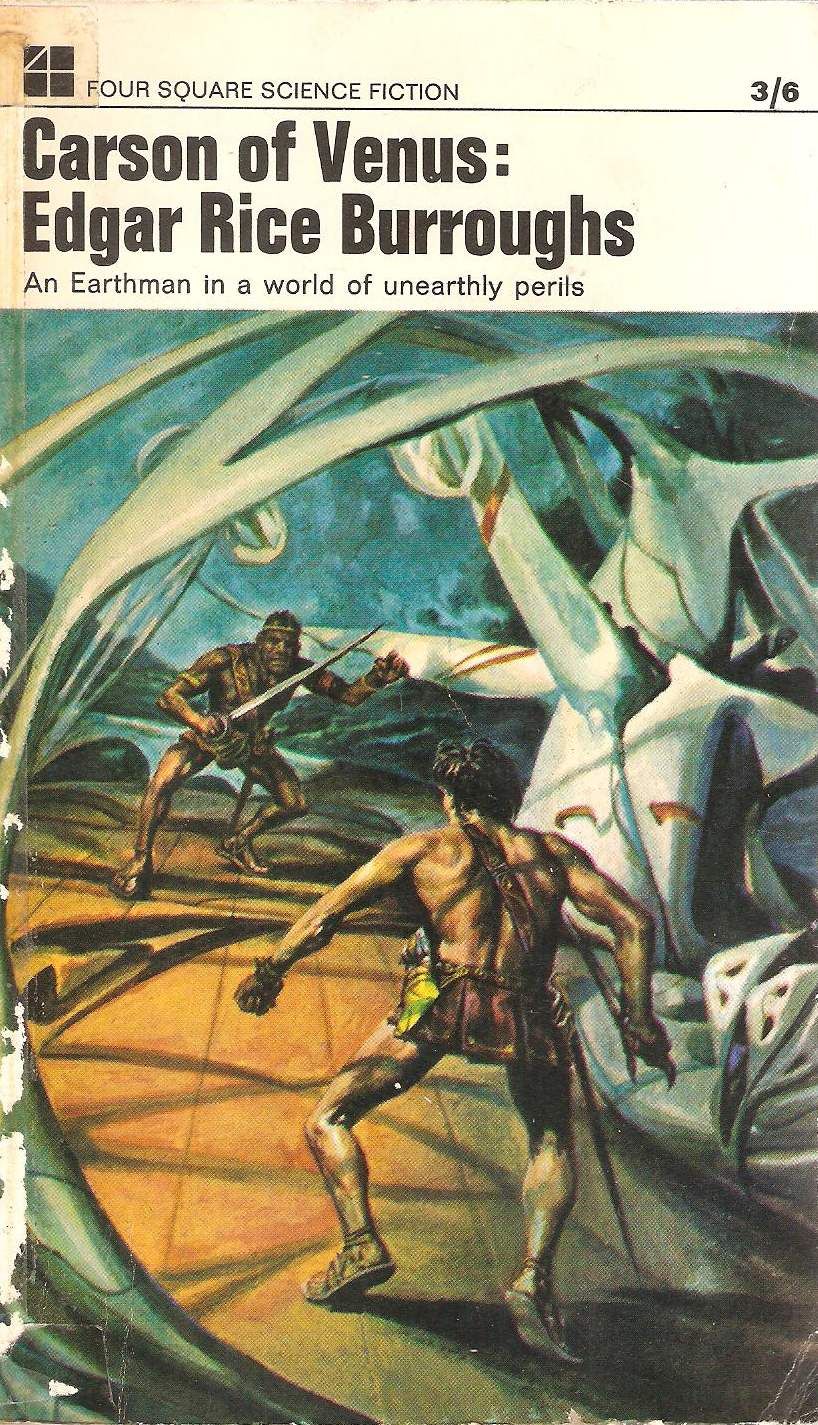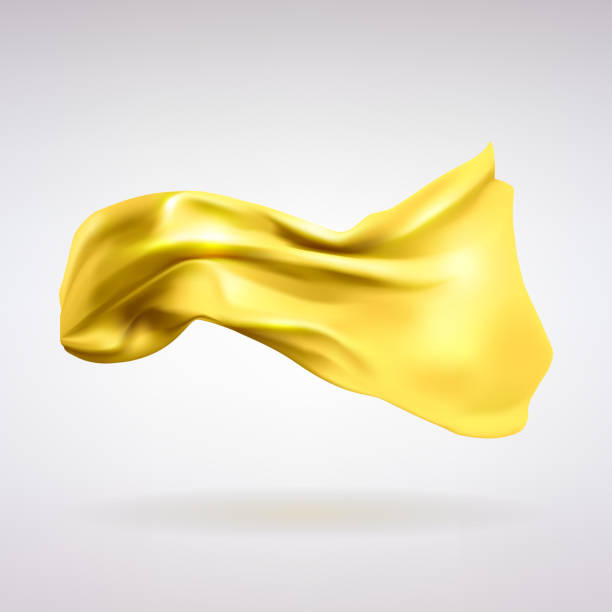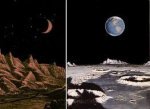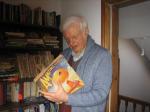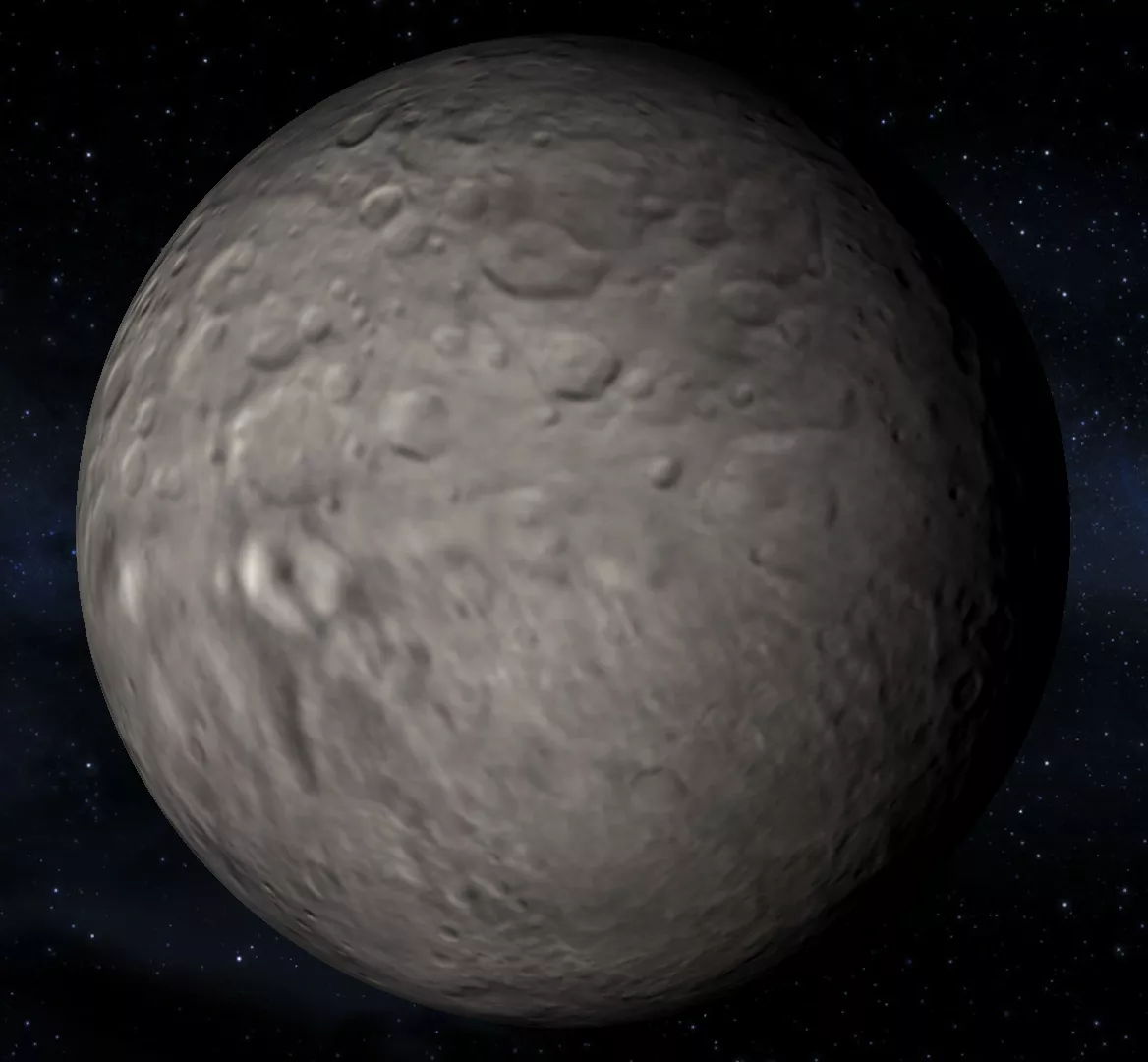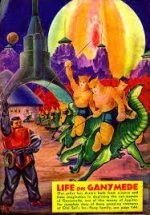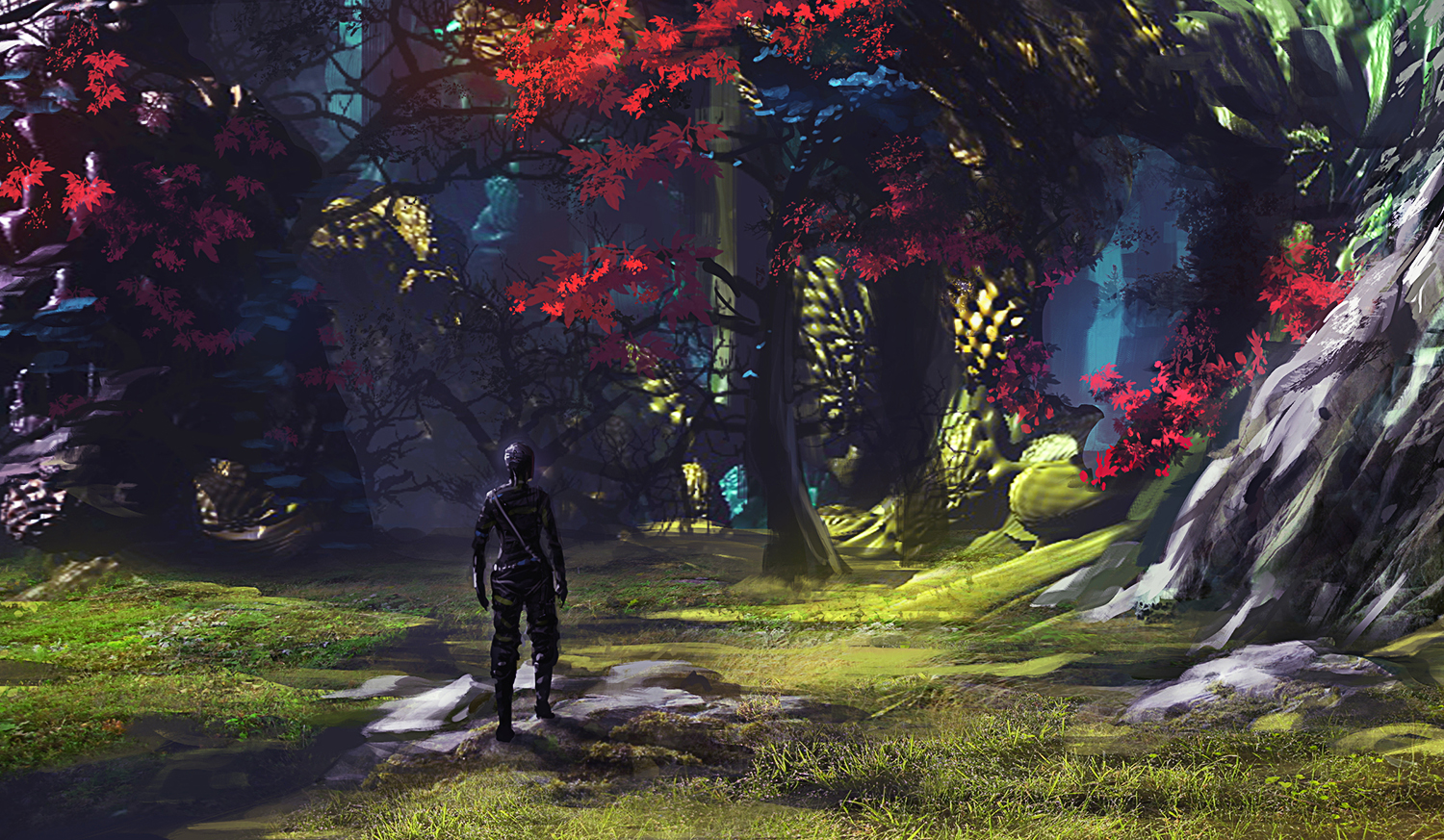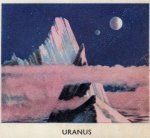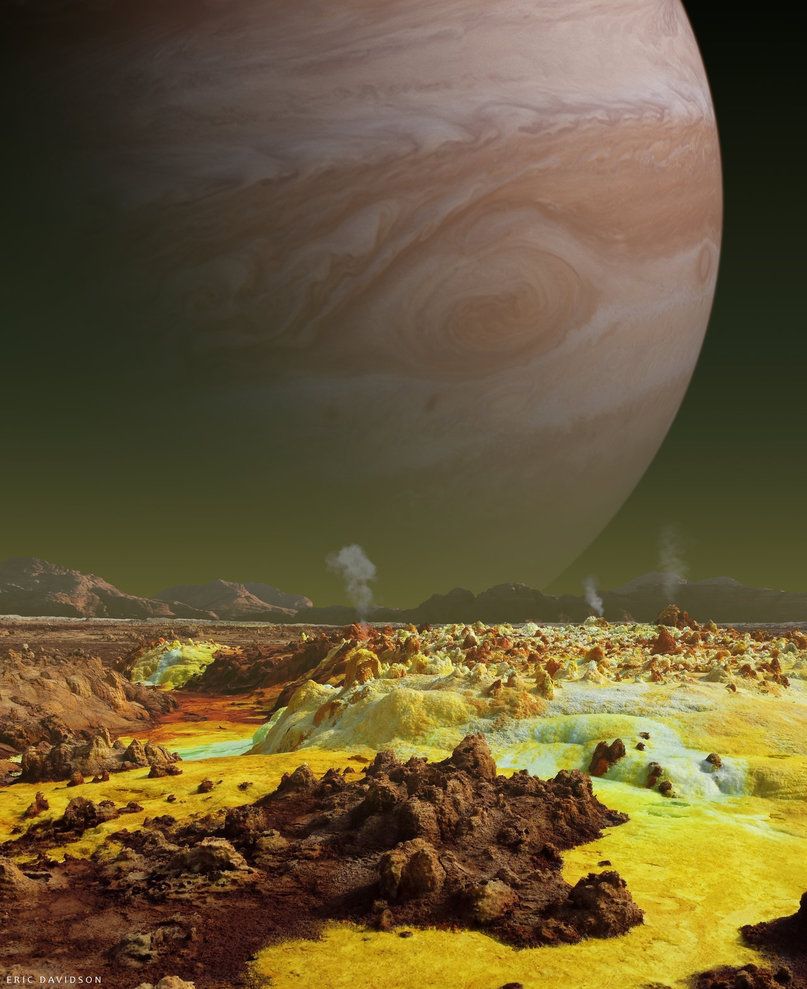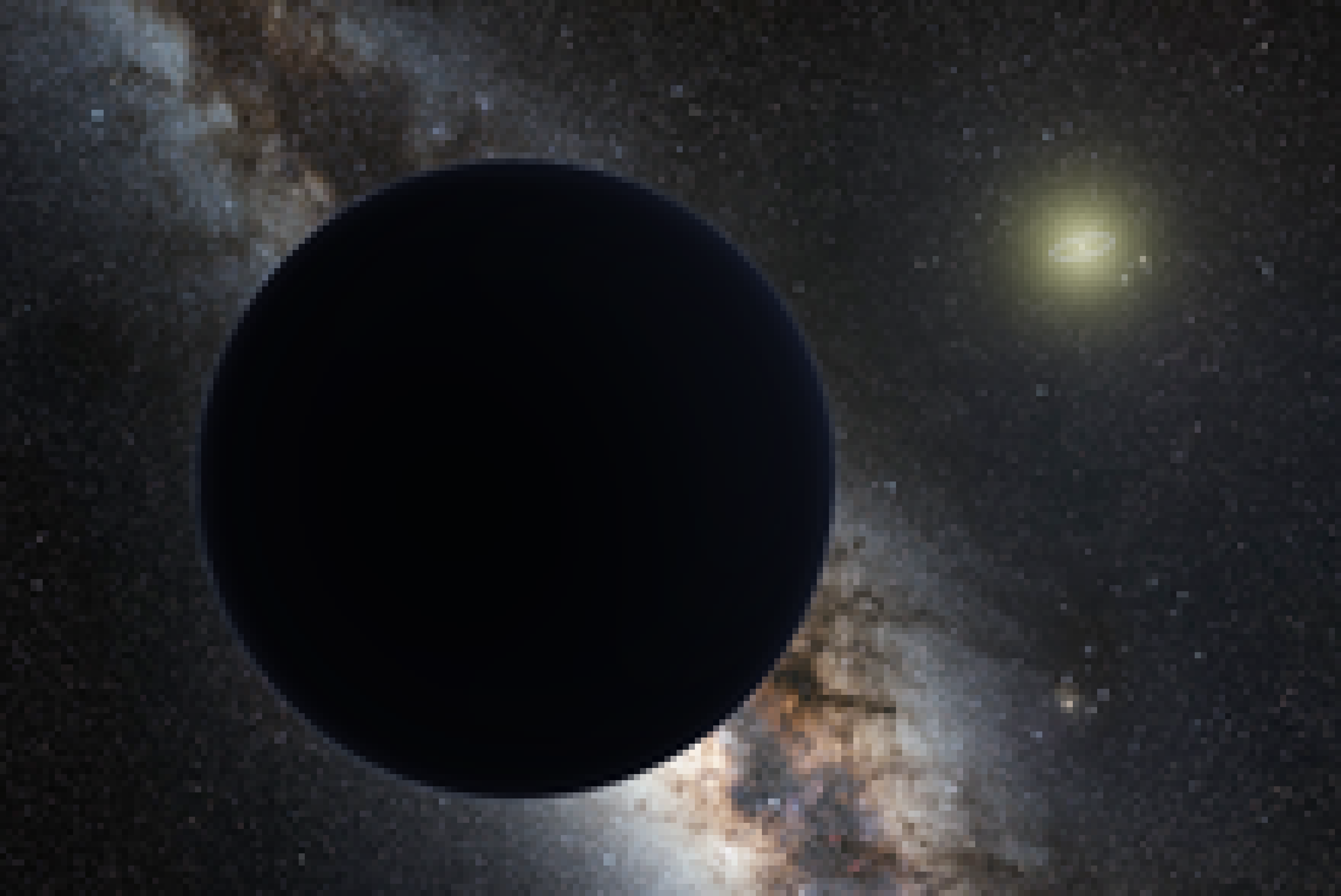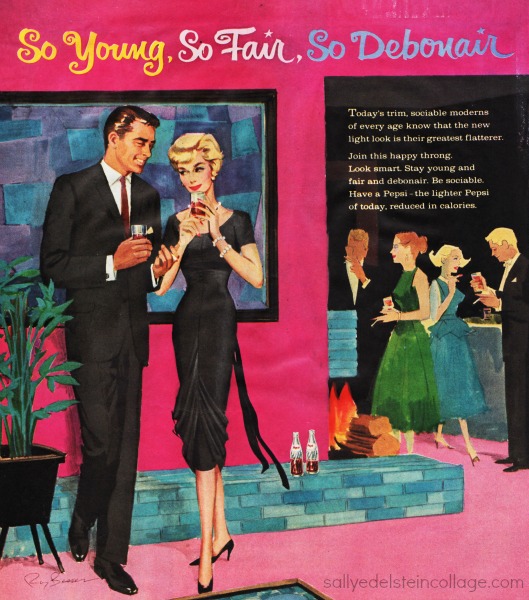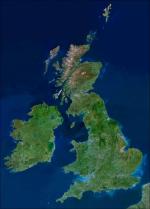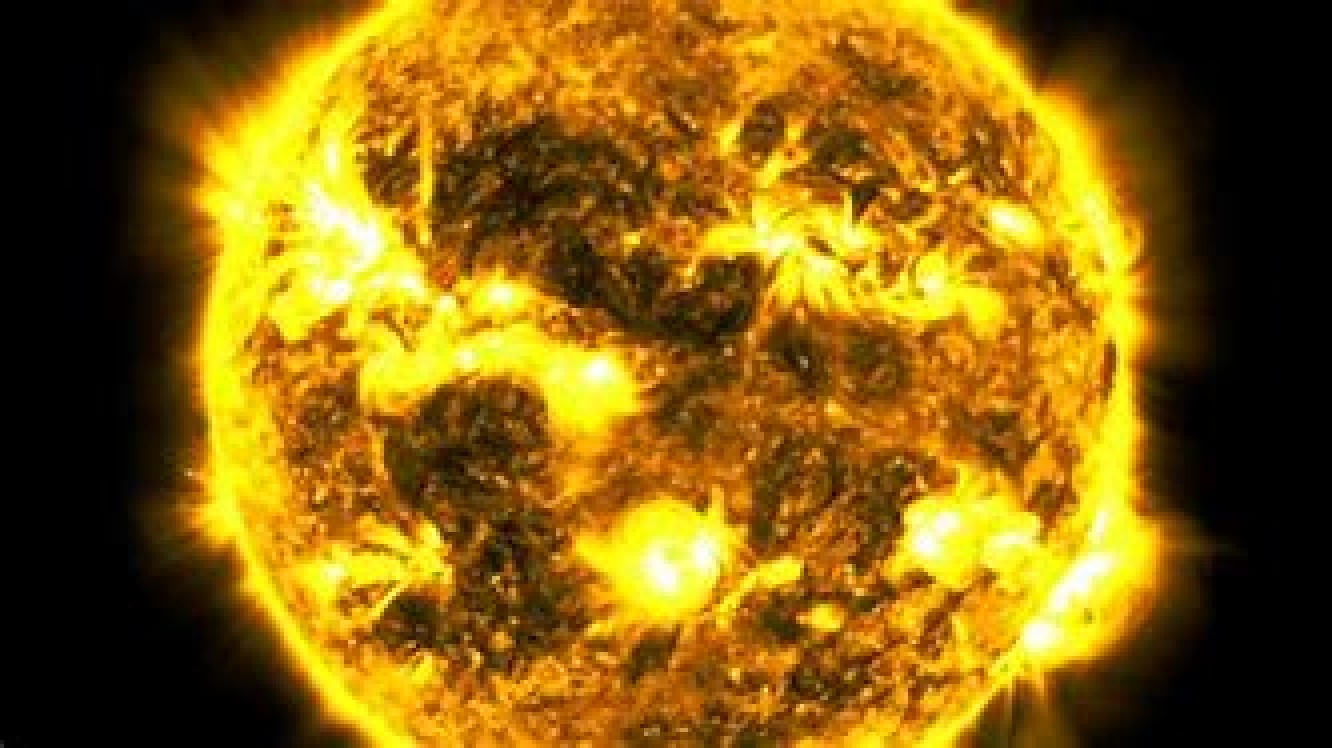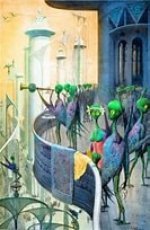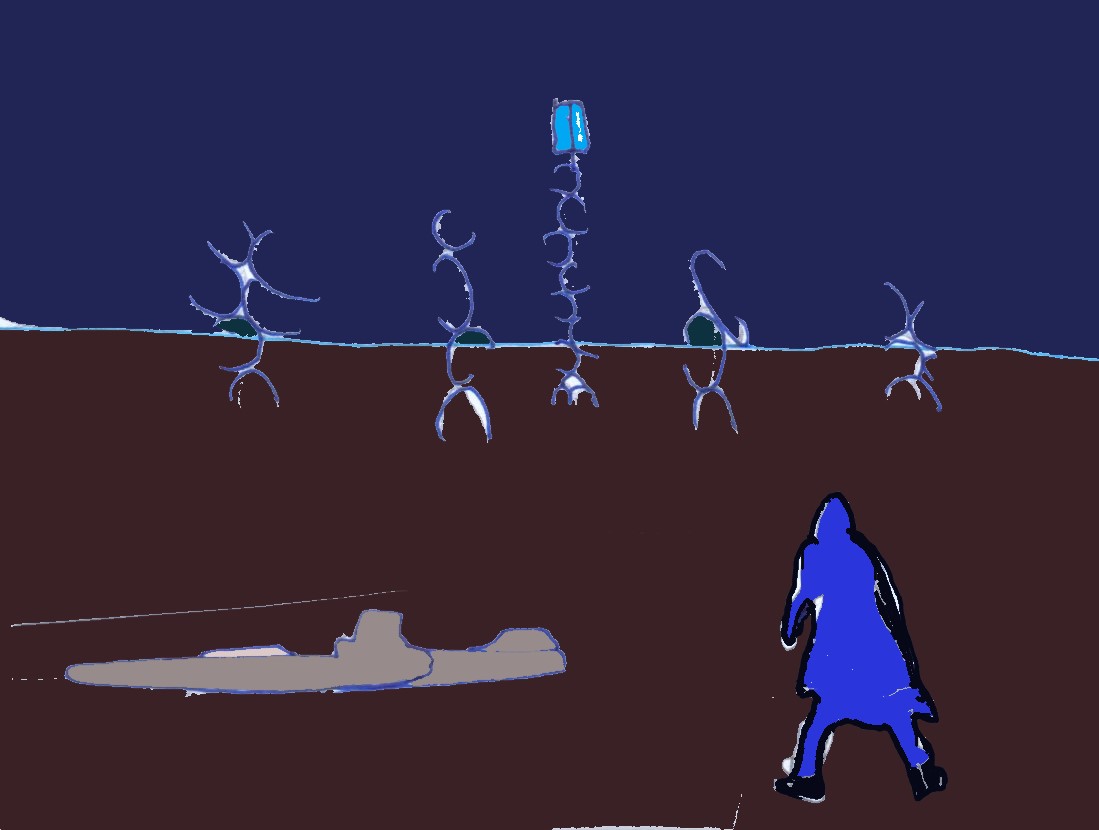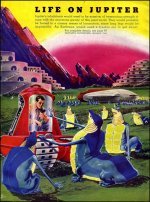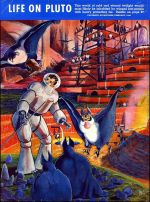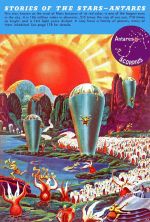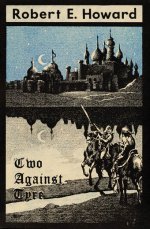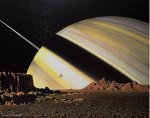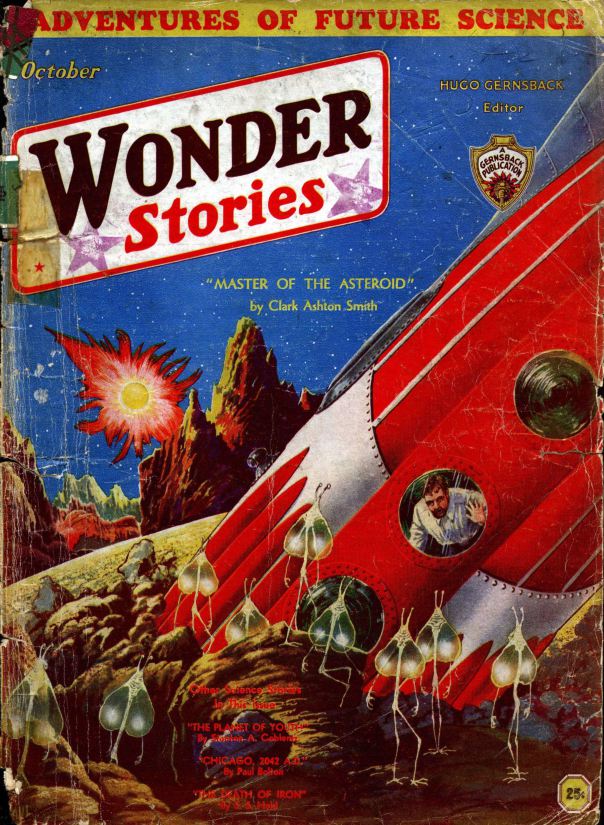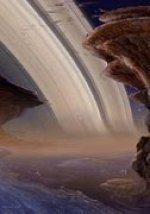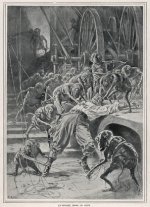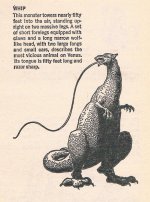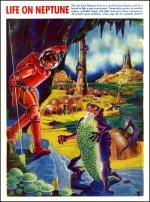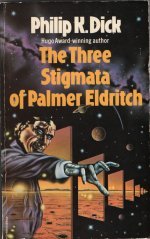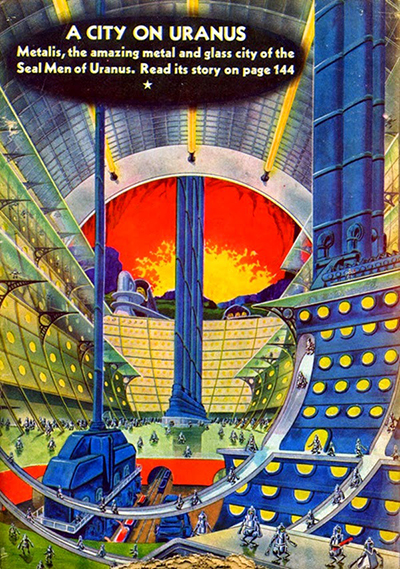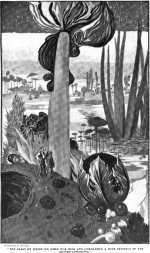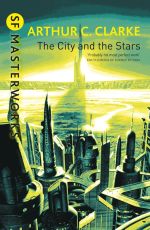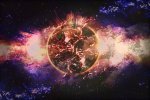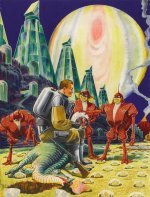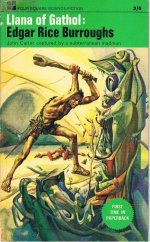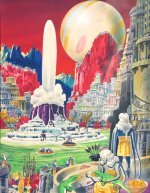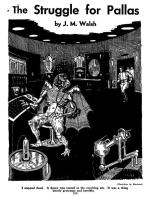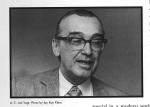what to see on
uranus
For a scenic browse, and an answer-page for Guess The World...
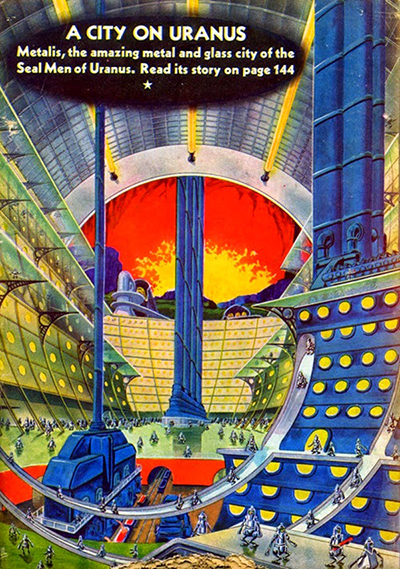 from Fantastic Adventures, April 1940
from Fantastic Adventures, April 1940dream of a polar palace on uranus
...The sunward polar city stood tall and proud in its glittering wineglass stem; stately airships and swarming skimmers clouded its aerial hangars and docks; from the midst of the upper reaches rose the Zairm...
The sight, though awesome, was as familiar as if he had lived in that palace as a child. Dreaming, he accepted this familiarity without question. Indeed there was no need to puzzle over it... He moved forward. He drifted through the palace walls. Like a thirsty ghost he sipped at that sense of belonging, he truly believed that he was really there... even if it were but a dream; for did not the act of thinking about a place mean that one's mind was there? Anyhow the place itself did really exist, and his soul belonged in it, here at the sunward pole... More real than real life, the dream's lemon-gold became the colour of knowing. This was the key awareness, awareness of the worth of what one saw...
The palace, he knew, was built of smollk, the foamed ore of Ammye; the pumicelike segments had accumulated age by age, till the Zairm was the size of a small mountain, rising from the upper platform of a still vaster city. Gengr viewed all of it simultaneously, being, in dream fashion, somehow both inside and outside the great structure. The crust of memory was thick. It reached across a geological age in the throne-room, Zdinth Hall...
Traditions - their weight and power - were what he was going to need after he had awoken...
Robert Gibson, The Worm of Poleva, in Uranian Gleams (2015)
city amid a uranian forest
...Bran, the city, proved to be a mass of drum-shaped buildings of dark metal, enclosed by a towering wall. This wall was faced or plated with the gray metal that was alone proof against the destroying-liquid, and on the rampart's broad top were mounted nozzle-projectors of great size. The wall was separated from the surrounding forests by only a few hundred feet of clear ground.
Some flying-disks were in the air over the city, departing or arriving like ourselves from over the limitless forest-wastes. Through them our own craft sped to come to rest on the immense flat roof of one of the city's taller central buildings. Our space-bell was placed upon the roof, and we were conducted down into the city.
Jean
and I found ourselves welcomed with the strongest interest by the
white-garbed Brans. They seemed a highly social people, and in fact we
learned that though this and their other cities held many tens of
thousands of them, they had no rulers and but the slightest skeleton of
government, dwelling together without need of more...
Edmond Hamilton, The Terror Planet (Weird Tales, May 1932)
phantasmal uranian shadows
"There!" she hissed. "There!"
He peered into the gray dimness. Nothing at all - or was there something? A shadow - but what here could cause a shadow, here in this sunless region of fog? A condensation of mist, that was all. But it moved; mist can't move without the thrust of wind, and here there was no wind.
He
strained his eyes in an effort to pierce the obscurity. He saw - or he
imagined it - a vast, looming figure, or a dozen figures. They were
all around; one passed silently overhead, and numberless others weaved
and swayed just beyond the range of vision. There were murmurings and
susurrations, sounds like breathing and whispering, patters and
rustles. The fog shapes were weirdly unstable, looming from little
patches of darkness into towering shadows, dissipating and forming like
figures of smoke...
>> Stanley G Weinbaum, The Planet of Doubt (Astounding Stories, October 1935)
uranian rail network
...Seemingly
immune to the ravages of time, the mighty Zinc Era network had left
Syoom criss-crossed with embankments on which the empty rails still
ran. Every few thousand miles, wayfarers were still bound to cross one
of these artificial ridges. On well-frequented routes this did not
matter at all; however, grim experience had taught that any stretch of
embankment which had not been visited for a thousand days or so must be
approached gingerly. Preferably, a dray-master, raft-pilot or Crawler
captain should send scouts ahead to peer cautiously over the rim, before
any attempt to get over with the main vehicle. And the more lasers on
one's side the better...
Robert Gibson, Greenery, in Uranian Gleams (2015)
life in the uranian caverns
White lichens towered above them like a grotesque forest. On the rock ledges above them he saw enormous bat-like creatures, their scaly white wings folded about them in sleep.
Following the guidance of the radite-compass needle, Captain Future entered the first tunnel that diverged north-eastward. A larger underground stream ran through it, broiling downward. The two intrepid adventurers pressed on.
"How much farther do we have to go, chief?" Grag demanded.
"Plenty far," was Curt's unpromising answer. "The intensity gauge on the radite-compass shows the deposit is still a long way off. And moderate that bellowing voice of yours, will you?" he added warningly. "The People of Darkness range through all these caverns."
"The cave-people they warned us about?" Grag said. "Who's afraid of them? They might have scared other explorers, but not me."
The connecting caverns seemed endless as Curt and the robot penetrated ever deeper...
He and Grag were moving down a dim chasm beside the waters of a racing little river, when Curt glimpsed something rushing towards them.
"Cave-spider!" he yelled, and grabbed for his proton pistol.
"Holy sun-imps!" gasped Grag...
Edmond Hamilton, The Magician of Mars (1941, 1968)
a mobile station on uranus
Uranus was lit by a tiny sun that cast an ineffectual light across a flat vista of blue-black ice. Crests of white showed white-diamond glints – not really snow, but a rime-ice. Below – somewhere at the end of the radar beam – was Station One.
Station One, doing something unpredictable, no doubt.
They dropped down, following the radar beacon until they saw it.
It had to be seen to be believed.
Uranus is mostly ice. Normally its gravity was enough to keep the ice cold-flowed into a reasonably flat surface. It is too cold to snow, too cold to rain, too cold to hail or sleet or hurricane or much of anything. But it is not too cold to grind together, to thrust one planetary block against another, to cause upthrusting mountain-ranges of ice which in the normal course of events will cold-flow into the resemblance of flatness. These up-thrustings are rare –
Station One had met one of these.
Strain develops slowly; an ounce at a time it builds up over a long period until a tremendous pressure develops. The pressure overcomes everything. Then, with two monstrous forces thrusting against one another, the angle of thrust will begin to change. The vector of force will become more amiable to the forces involved and the whole vista then drives forth along the new direction of resulting motion. In the case of planetary thrust, this direction is upward, causing mountains.
Forty miles high the mountain of cold-flowed ice had risen. Up and up and up in a rising pillar, a rising pyramid until the top, bowed over by some trick of angular force until it leaned sidewise, broke from the mountain top and came tumbling down the side of the slope in a giant avalanche.
There was neither rock nor stone; only ice.
Station One was a huge structure of metal and concrete, driven by an atomic pile contained inside of it. It moved across the face of Uranus on tractor-treads that depressed acres with each planting of a monstrous foot. It left behind it a trail that might someday amaze some visitor from somewhere-else.
George O Smith, The Planet Mender (Thrilling Wonder Stories, April 1952)
>> Guess The World - Third Series
rebuilt on uranus
...Her eyesight was improving... she tried to focus on the beings in front of her... The one in the golden robes stopped talking with the others and came and stood before her...
"...We
found what was left of you and your vessel in the wilds of our planet
where you were critically injured. We know much about your planet...
but we don't have the medical knowledge or the biological material to
repair all your neurological functions...
“We adapted the components to rebuild you but... we could not reconnect all your nerves; however you will be able to move around. We added neural training so you can understand and speak our language...” He watched her for her reactions.
The unreality of her situation was too much and her mind snapped and panic broke through her normal discipline. She tried to scream but nothing came out... Her mind was racing to catch up because everything she was seeing and experiencing was impossible! Uranus was a cold gas planet, it didn’t have the lush green landscapes… it didn’t have civilization… She didn’t even know if she had a body any more. It was too much and she lapsed back into the darkness of unconsciousness.
Jamie Ross, Beyond Despair (Vintage Worlds 2, ed J M Greer and Zendexor, 2020)
>> Guess The World - Third Series
the mountains and waters of uranus
…the titanic mountains of Uranus are its best-known natural feature.
There are no mountains elsewhere in the Solar System like them… Even the smaller ranges soar to heights of five and ten miles. Many of the great peaks are very much higher. And there is one colossal range in the northern hemisphere, called the Mystery Mountains, which have an altitude of at least twenty miles…
…radioactive matter is responsible for another of the wonders of the seventh planet – the Shining Sea in the southern hemisphere.
It is a sea whose waters are so impregnated with radioactive material from deposits in its bed that it glows at night like a great lake of light. The Uranian city of Lulanee is built on the shores of the Shining Sea, and is considered by interplanetary travelers to possess one of the most beautiful settings of any city in the System.
Another remarkable natural feature of Uranus is the Endless River. This is a torrential stream which flows around the whole planet near the equator. Its waters are kept flowing in an endless course, tugged by the tidal pull of the four moons of the planet…
Article Uranus, the Mountain World in Captain Future, Summer 1941
>> Guess The World - Fourth Series
an incarnation of evil on uranus
Just a little pool, ten yards across perhaps?
“So,” breathed Hyoen, “not quite all the lake has gone.”
Nobody answered her because they all became paralyzed by the sight of what was happening on screen. The stagnant water had begun to ripple. After a minute or two the surface broke. A black and glistening object reared out of it, and unfolded in the open air. The four watchers immediately understood the purpose of the arrangement of relayed transmissions. What they were seeing, if perceived directly, would have blown their minds.
The thing shook the drops from its scaly skin and from its black wings as it rose out of the liquid. Undeniable evil bulged from the head. Blurry eyes and sagging mouth offered a message dismaying beyond all reason. No use to say it was “only” this or “only” that. Certainty flooded the watchers: this was…
They knew, but did not want the thought of it to form.
A thing that should not be. Should not count as real, anywhere in our universe. But it was here, a nightmare tresspassing in daylight, as it clambered and waddled out of the pool and fully onto the shore, where it strutted, turning its eyes this way and that.
Robert Gibson, Basilisk in Uranian Gleams (2015)
>> Guess The World - Fourth Series
blossoms in the caverns of uranus
…I know
What clammy blossoms, blanched and cavern-grown,
Are proferred to their gods in Uranus
By mole-eyed peoples…
Clark Ashton Smith, The Hashish Eater (1920)
>> Guess The World - Fourth Series
being briefed on the inhabitants of uranus
The recital started early. The auditorium was packed. Many of those there had been on Uranus and knew what the Uranians were like. The recital was old stuff to them. …They heard how the ships approached Uranus with no lively hope of finding anything worth while – of everyone’s surprise to discover an advanced civilization flourishing there. They heard the transcribed voice describing what the Uranians looked like:
“…They have three legs and three arms each composed of three segments of massive bone surrounded by a heavy layer of fat and leatherlike skin. Each limb terminates in a small prehensile finger. …The top portion of the body has three eyes, three nostrils, and two mouths. One mouth is used for water, the other for food. In appearance, the Uranians seem outlandish to Earthly eyes. They walk…”
…They looked like a three-armed watermelon sitting upright on a three-legged stool. A man could drive himself nuts trying to keep track of how they walked. Two feet were always on the ground, the third one moving forward… And he could change direction with the startling suddenness of an ant. His body wouldn’t turn at all; he’d just suddenly begin moving off at a tangent.
“…no language as we know it. They communicate with one another in short bursts of sound which verge on the supersonic. We understand their speech only by means of instruments which graph the duration and pitch of the sounds they make…”
Theodore L Thomas, The Fatal Third (Planet Stories, November 1953)
>> Guess The World - Fourth Series
[see also the Fictional Dates page for 2072]
speculation regarding life on uranus
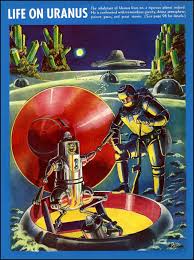 one of Frank R Paul's illustrations for the article (the other is at the top of this page)
one of Frank R Paul's illustrations for the article (the other is at the top of this page)...We walk through the thin, powdery snow, and we pass one of the metal domes. It’s hollow, but there’s no answer to our pounding. We pass on. But we’ve been observed. The next dome opens, startling us. Peering at us, we see a queer metal being. No, he’s not metal. It’s a suit he’s wearing. He remains motionless, regarding us with a cold stare. We come closer.
We see a queer, tiny green-furred being. He seems unafraid. But we feel certain that he’ll pop down if we make an overt move, and slam his dome down over him again. Reminds us of a ferret, somehow.
Approaching, we signify by sign language that we intend no harm, and we descend into the interior of the Uranian's queer home. We are amazed. We find a veritable little city, all self-contained in metal…
…the Uranian now takes off his suit and reveals himself as a squat, little fellow, with webbed legs, short and powerful, and tiny, many fingered hands, with webbing between them.
Obviously, he is partly amphibian. We learn to our astonishment that he is able to descend below the ice crust of the planet, and swim like a seal in the water below, where grows his food supply…
…The eggs are deposited in the warm waters, in clumps of floating weeds, and there hatch, to develop into tadpole-like creatures which develop later into the full-grown quasi-amphibian Uranian.
Evolution has driven this being to prepare himself for an ultimate life on a world which will be entirely frozen, and the watery underworld no longer exists as the planet loses its natural heat.
Thus, the city we entered is the forerunner of Uranian surface cities built on everlasting ice. At present they are temporary affairs, capable of floating at the season of melting...
Henry Gade, Life on Uranus (Fantastic Adventures, April 1940)
>> Guess The World - Fourth Series
